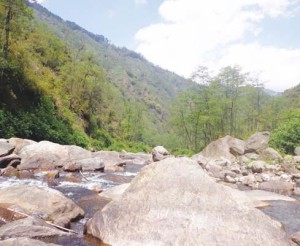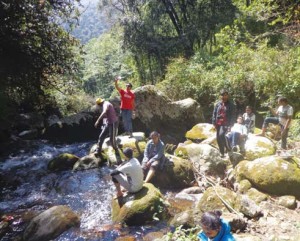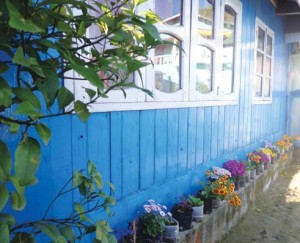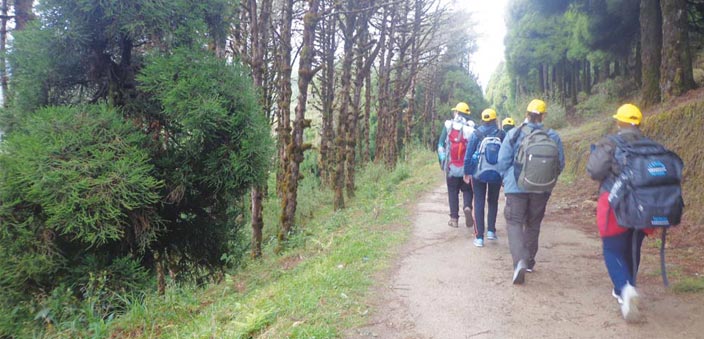
Trekking to Himalayas? Are you sure you can do it? Don’t you need to undergo extensive physical training before doing so? These and many more questions came my way when I first pitched the idea about my Himalayan trek. The organisers of the trek assured me that as long as I was physically fit, I could complete the Sandakphu – Gurdum trek that I had signed up for. The trek incidentally was also called a ‘ladies trek’ by one of the camp leaders we came across later, who said that it was one of the easiest of all the Himalayan treks and hence the best one to start with.
It is also one of the most scenic ones as the trek route takes you from the cold hilly areas of Tumbling and Kalipokhri in Nepal to Sandakphu, from where on a sunny day you can see both the snow covered Mt Everest and Kanchenjunga. The trek route to Gurdum goes through a forest that is covered with blooming flowers in the month of April and May; they seem to give you a warm welcome. A part of the route goes through Singalila National Park in the northern part of West Bengal, and if you are lucky you might just spot a red panda or two while on your way.

I did my trek with the Youth Hostel Association of India that offers a range of treks at extremely economical prices. Our reporting base camp was in Darjeeling which can be reached either by taking a private transport from the nearest Bagdogra airport or a train from Kolkata to the New Jalpaiguri railway station, and then a bus or private transport to the beautiful, fog covered hill station of Darjeeling.
Unpredictable Himalayan weather
The trek is best done in summers as the temperatures in most places would remain between 0-10 degrees. Backpack with a first aid kit, lots of warm clothes, gloves and raincoat are a must before you embark on the trek. You cannot carry a trolley or any other kind of bag as your hands need to be free as you trek. While summers might mean soaring temperatures for the rest of the country, in the Himalayas it simply means that on some days you might be able to walk around with just two layers of clothing. If you have never seen snowfall, you might just get lucky as the raindrops suddenly turn into small snowflakes here.

The weather in Himalayas is very unpredictable. One moment you might feel the need to remove your woolen clothing and in the very next, seemingly out of nowhere, fog covers the area and your fingers go numb. All this happens in a matter of seconds and you suddenly find yourself frantically reaching out for warm clothes.
Get, set, trek!
Our Himalayan trek began at Dhotrey, an area close to the West Bengal-Nepal border. We were told that two of our camps, where we would spend our nights after an entire day of trekking, would be in Nepal – Tumbling and Kalipokhri, while two others – Sandakphu and Gurdum – would be on the Indian side. During the trek we were moving in and out of Nepal, all without any hassles, making it easily one of India’s friendliest borders. The trek route passes through the Singalila National Park and if you are lucky you will spot a red panda, like we did, as it slept peacefully on one of the branches of the lush green trees that surrounded both sides of the trek route.

Colourful butterflies, a variety of birds and flaming pink rhododendrons make the trek route a nature lover’s paradise. The trek from Dhotrey to Tumbling in Nepal has trekkers walking amidst towering mountains and pristine greenery. The fog flits in and out, enveloping the mountains in an instant and clearing out to leave us spellbound with the sight of the mighty Himalayas. At Tumbling the temperatures began to fall. Several village homes are built right on the India-Nepal border. Some homes are on the Indian side while others on the Nepali side. The homestays serve simple but delicious food with potatoes and cauliflower the only two vegetables that we ate throughout our journey. Variety is not one of the specialities of a high altitude diet!
From Tumbling we trekked higher to Kalipokhri. Here there is a water body with dark inky water which almost looks black. Hence the name ‘kali’ which means black in Hindi. At Kalipokhri, Himalyan yaks will make an appearance along with domesticated cows. One can even spot eagles soaring high, looking majestic against the backdrop of the rocky mountains.

Life without thick woolen caps and even thicker gloves becomes difficult here as the cold Himalayan winds blow strong. The view of the surrounding mountains and the greenery below continues to get more stunning with each step into the higher altitudes.
Face to face with the mighty Everest
We next headed to the highlight of our trek – Sandakphu, the place from where on a sunny day one can get a clear view of the snow covered Mt Everest and Kanchenjunga mountains. While the uphill trek is arduous, we woke up at the crack of the dawn to watch the sight we had trekked all this distance for. Our group which had 25 other enthusiastic trekkers from different states of the country couldn’t hide their excitement when the fog cleared and the snow covered peaks made an appearance. Temperatures were sub-zero, the wind so strong that even the well built found themselves swaying, and yet, all of us had eyes only for the mountains – Mt Everest and Kanchenjunga.

For almost all of us, this was one image that remained the highlight of the journey. Cold and strong winds notwithstanding, we watched in awe at nature’s majestic creations.
Trekking down
If mountains dominated our route while trekking up, it was time for the Himalayan forests to entice us with flaming pink rhododendrons and a carpet of thick green moss. The landscape on the way to our next halt in Gurdum was a treat to our eyes as butterflies flitted among the multi-covered flowers and lush green forests welcomed us.
While trekking down appears relatively easy compared to the ascent, it is hard on the joints and a majority of those in our group ended up with injuries during this leg of the trek. The almost 14 km trek down ended at Gurdum, which has quaint villages nestled in the luscious Himalayan landscape. We spent the second last night of our trek at a homestay here which was surrounded by pretty potted plants with seasonal flowers. Temperatures now were fairly warm and the gloves and woolens were no longer needed.
Last day of the trek
Our last halt was at Rimbik in the Darjeeling district, which required us to trek further down from Rimbik. As we walked, our ears picked up the sound of flowing water. We strained our eyes to see clear, cold water gushing down the mountain in a stream and in an instant all our faces lit up. Not ones to miss the fun, our group plonked itself near one such stream, stopping for some pictures and gulps of the pristine white water.
As we walked further, we passed several more villages and the terrain changed to motorable roads. Small cozy homes dotted the landscape and markets that closed by six in the evening made an appearance. The place seemed to slowly nudge us to get used to city life again, with the beautiful journey that we had just undertaken, settling down as a cherished memory in our minds.
What more at Darjeeling?
From Rimbik we were brought back to our base camp in Darjeeling in a private vehicle. It would be a good idea to stay back at the hill station for a day or two more as there is plenty to explore from its vast tea gardens to the Japanese temple. You can even try your hand at rock climbing and for those interested in history of mountaineering, the Himalayan Mountaineering Institute is a must see. Gangtok too is merely at a distance of five hours and is recommended for those who have not yet had their fill of the mighty Himalayas.


